Alex Flemming | Série Alturas
16 de Agosto - 16 de Outubro de 2021
Telmo Porto
Diretor da Galeria Arte 132 | Director of Galeria Arte 132
Arte132 é uma galeria de arte e um lugar para amigos se encontrarem.
Para sinalizar este duplo objetivo, sua inauguração envolve amizade – de 40 anos! – com Alex Flemming, artista de carreira consolidada no Brasil e Exterior. Basta ler a cronologia que finaliza este catálogo.
Alex personifica a vocação verdadeira para a Arte: necessidade de produzir, consistência conceitual e vontade constante de experimentar.
Sua produção, constituída por séries, manifesta justamente tal aparente contradição: experimentar e ser único.
Também a resiliência, pois ser artista não é fácil! Envolve persistência, incertezas e riscos.
Há, nesta mostra, três envoltórias de acolhimento: a amizade com o artista, a admiração do pintor por seus modelos e a vontade de receber visitantes.
Neste primeiro catálogo, cabe ainda escrever algo sobre as próximas exposições e acervo.
Arte132 será dedicada a artistas inscritos na História da Arte brasileira. Nem sempre os mais valorizados pelo mercado. O que se pretende oferecer são obras que reflitam o tempo em que foram criadas, contemporâneo e passado, e que possam ser adquiridas como testemunho, para filhos e netos, do próprio gosto, sensibilidade e crenças. Obras que mantenham seu poder de propor e deslumbrar.
Pretendemos rever nomes de contribuição consistente e pouco vistos e a produção mais intimista ou ainda inédita dos mais reconhecidos. Papel como suporte será frequente.
Também pretendemos ter música, canto, projeções e encontros com especialistas.
English version
Arte132 is an art gallery as well as a meeting spot for friends.
Signalizing this double goal, its inauguration involves a friendship – of 40 years! – with Alex Flemming, an artist with an established career in Brazil and abroad (it is enough to read the timeline that ends this catalog).
Alex is the very personification of a true vocation for art: the need to produce, conceptual consistency, and a constant urge to experiment.
His production, consisting of various series, demonstrates this same apparent contradiction: to experiment and to be unique.
Also toughness, because being an artist is not easy! It involves persistence, uncertainty and risk.
This show involves three layers of welcome: the friendship with the artist, the painter’s admiration for his models, and the desire to receive visitors.
In this first catalog we should also tell something about our upcoming exhibitions and our collection.
Arte132 is dedicated to artists who have played a significant role in Brazilian art history. And these are not always the ones most highly valued by the market. The gallery aims to offer works that reflect the time in which they were created, whether contemporary or in the past, and which can be acquired as a sign and record, for sons, daughters and grandchildren to know one’s taste, sensibility and beliefs.
Artworks that maintain their power to propose and to awe.
Our aim is to raise awareness about artists with a consistent yet less visible contribution, or with a more intimist or even more pioneering production than many artists in the limelight. Works on paper will be frequent.
Our planned programming also includes music, song, screenings and meetings with specialists.
Angélica de Moraes
Crítica de artes visuais e Curadora independente | Art critic and independent curator
Autora do livro “Alex Flemming” (Ed. Cosac Naify, SP, 2012) | Author of the book “Alex Flemming” (Ed. Cosac Naify, SP, 2012)
Quando mergulhamos o olhar na série de pinturas “Alturas”, de Alex Flemming, é inevitável ficarmos seduzidos pela força colorista que emana do conjunto. Há nessa imantação tanto a memória da História da Arte como seu aggiornamento. O artista realiza de modo original uma outra proposta para o gênero retrato. Coerente com o foco de sua obra, fortemente ancorada na figura humana, ele substitui a imagem do corpo pelo índice da presença: a régua que informa a altura do retratado.
Há aqui uma dupla operação de linguagem. A figura se torna abstração e a neutralidade do fundo é subvertida por imagens multiplicadas por estêncil (técnica que integra seu vocabulário desde os tempos pioneiros do grafitti paulistano) ou por gestos rítmicos do pincel em igual voltagem de acontecimentos visuais do primeiro plano e disputando com ele a atenção do olhar. O estêncil é também recorrente nas letras, traçadas a normógrafo, ou seja, dentro de um padrão. O que se harmoniza conceitualmente com o padrão do sistema métrico para criar um estranho paradoxo: as pessoas retratadas são aquelas que, dentro de suas atividades específicas, fugiram ao padrão graças aos talentos que sabem exercer.
”Alturas” é a mais longeva e extensa série entre tantas que o prolífico artista costuma tocar em paralelo. Trata-se da celebração da Cultura produzida por personalidades as mais diversas, do Brasil ou do exterior. Iniciada em 1988 e realizada de modo ininterrupto desde então, é também um caminho para a percepção de sucessivas fases da produção pictórica do autor. Podemos afirmar até que é quase um resumo de todos os caminhos por onde andaram seus pincéis. O quase fica por conta da prudência necessária à análise de obra tão fértil em experimentações e hibridizações de meios, processos e linguagens ao longo de mais de quatro décadas.
A gênese de “Alturas” é muito própria e até autobiográfica. Com a clareza e a objetividade que caracterizam as idéias realmente criativas, Flemming apropriou-se e expandiu em pintura um antigo hábito incorporado ao cotidiano doméstico da sua família: medir o crescimento dos filhos. Quando garoto, habituou-se a ter sua altura conferida em uma régua de traços construída e acumulada em uma parede da casa ao longo dos anos e das mudanças graduais de estatura.
O procedimento, que ele replicou para todos seus retratados, consiste em tirar os sapatos e, de costas para uma tela previamente preparada e in progress com outras marcas-retrato, ficar imóvel para também ter sua estatura mensurada. Inevitável pensar que o personagem, nesse momento, pode ter conversas consigo mesmo e seu ego sobre como estará situado nesse ranking. Mas não é um ranking. Não se trata, é óbvio, de associar altura com qualidade de contribuição artística. Muito pelo contrário. O artista frisa que foi movido pelo desejo de sublinhar a importância da diversidade. “Todos somos iguais e todos somos diferentes”. A diversidade cultural é o valor celebrado.
Tirar os sapatos também tem carga metafórica: é o retorno ao chão, “de onde viemos e para onde vamos”, observa Flemming, que carrega consigo o atávico pendor germânico para os abismos existenciais da “Angst”.
O conceito de medir é subvertido, portanto, por outra escala de valores: a relevância cultural, entendida aqui não só na esfera das Artes mas também de outras atividades que, somadas, definem a cara do que é estar no mundo hoje e as muitas contribuições que tivemos para estruturar nossa própria visão de mundo, cada vez mais fragmentária e contingente, caleidoscópio de muitas facetas iluminadas que se completam por oposição ou complemento. Ou, como observa o autor, “um diapasão de comportamentos”.
A remissão ao universo da música é necessária também para observarmos o contraste entre os ritmos de tinta que dançam ao fundo e as escalas de cores sólidas recortadas em régua que regem o primeiro plano. “Hoje a gente pode ver essa série de telas até como um código de barras de nossa época”, observa o pintor.
Sem dúvida. Há algo de único e objetivamente identificador nessa soma de personalidades que não são agrupadas por atividade mas resultam do acaso de estarem acessíveis ao convite do artista para visitar seu ateliê e aceitar o jogo de ingressar na tela sem privilégios de lugar e até mesmo de vizinhança.
“Há, por vezes lado a lado, pessoas que representam idéias antagônicas”, observa. As letras de normógrafo que, de modo criptográfico, seguem a verticalidade das réguas-personagens são índice do vocabulário visual do artista e que adquiriu sua face mais conhecida ao ser inserida na paisagem paulistana: remetem aos painéis fotográficos vitrificados da Estação Sumaré do metrô e da Biblioteca Mário de Andrade, dois poderosos ícones da presença da obra de Flemming em sua cidade natal.
O diálogo com a História da Arte se faz porque Flemming propõe uma resposta contemporânea a uma pergunta que remonta à Renascença e aos tempos pré-fotográficos. Qual a altura dos retratados? Essa informação podia ser (e era) substituída ou distorcida por escalas de valor agiográfico ou laudatório de algum poderoso mecenas, por exemplo. Os artistas sacros tinham uma obsessão: saber a altura de Cristo. Rafael Sanzio teria resolvido o dilema estabelecendo o padrão, por meio de elementos arquitetônicos (como colunas) que situavam a escala humana em suas obras.
“Desde 1989 mantenho no ateliê uma tela com fundo preparado a esperar os convidados retratandos”, conta o pintor. Essa disciplina de produção se manteve quando passou, em 1991, a ter dois endereços residenciais: em São Paulo e Berlim. Em ambos, há ateliê com essas telas in progress, daí resultando um panorama riquíssimo de diálogos culturais e protagonismos definidores de épocas, atitudes e conjuntos de valores culturais indeléveis em ambos os lados do oceano Atlântico.
A presente mostra é um recorte representativo dessa produção e também abrange um arco de tempo generoso. A lista de personagens de cada quadro é um convite a checar contribuições e verificar a porosidade delas em nós. O elenco é extenso, cheio de surpresas e descobertas de outros contextos geográficos e culturais ao lado de valores consagrados que já habitam nosso acervo de memórias. Há especialmente aqueles que nos ajudam a perceber de que amálgama somos formados e que conjunto de valores nos mantém em pé como pessoas e cidadãos.
Ao destacar essas personalidades, Flemming chama a atenção e homenageia de modo muito assertivo o valor estruturante da Cultura como indissociável de uma cidadania reverente à Vida. Celebra as medidas de nossos sonhos, que costumam transbordar de circunstâncias e restrições de momento.
English version
Gazing at the paintings of the Alturas [Height] series, by Alex Flemming, we are inevitably captivated by the colorist appeal of the overall set. This attraction stems in no small part from the memory of art history and its aggiornamento. The artist has come up with an original proposal for the genre of portrait. In keeping with the focus of his work, strongly anchored in the human figure, he replaces the body’s image by the index of its presence: a ruler that depicts the height of the person portrayed.
Here there is a double operation of language. The figure becomes an abstraction and the neutrality of the background is subverted by images multiplied by stencil (a technique that has been part of the
artist’s vocabulary since the pioneering days of graffiti in São Paulo) or by rhythmic brushstrokes that provide an equal voltage of visual happenings in the foreground, vying for the viewer’s attention. Stenciling also recurs in the letters, drawn using a nomogram, that is, in accordance with a pattern. This harmonizes conceptually with the standards of the system of measure to create a strange paradox: the people portrayed are those who, within their specific fields, are outliers in terms of their talent.
Alturas is the most long-standing series among the many the prolific artist develops in parallel. It is a celebration of the Culture produced by a wide range of personalities, from Brazil and abroad. Begun in 1988 and continuing uninterrupted since then, it is also a path for perceiving the successive phases of the artist’s pictorial production. It can even be considered as nearly a summary of all the paths along which his brushes have traveled. “Nearly,” because great care is needed in analyzing an artist so fertile in experimentations and hybridizations of media, processes and styles over the course of more than four decades.
The genesis of Alturas is uniquely personal and even autobiographical. With the clarity and objectivity that characterize really creative ideas, Flemming appropriated – and expanded in his painting – a long-standing, everyday household practice of his family: measuring the growth of children. When he was a boy, he used to have his height measured against a stack of accumulated hash marks on the wall, showing his progressive increase in height over the years.
A specific procedure was used in all the portraits of the series: the portrayed person takes off his or her shoes, and, facing away from a previously prepared canvas, already in progress with other portrait-indexes, remains motionless while the measure of his or her height is taken. One cannot help but think that the people portrayed might at this moment have conversations with themselves and their ego about how they might be situated in this ranking. But it is not a ranking. It is obviously not about associating height with quality or artistic contribution. Much to the contrary. The artist says that he was driven by the desire to underscore the importance of diversity.
“We are all the same and we are all different.” The value celebrated here is cultural diversity.
Taking off one’s shoes also has a metaphorical sense: it is the return to the ground, “from whence we come and to where we go,” observes Flemming, who bears within himself the Germanic atavistic bent for the existential abysses of “Angst.”
The concept of measuring is subverted, however, by another scale of values: that of cultural relevance, here understood not only in relation to the arts, but also to other activities which, all together, define what it is to be in the world today, while they also contribute to the structuring of each individual’s worldview – which is increasingly more fragmented and contingent, a kaleidoscope of many illuminated facets, combined by opposition or complementation. Or, as the author observes, “a tuning fork of behaviors.”
The reference to the world of music is apt for us to observe the contrast between the rhythms of paint that dance in the background and the series of solid colors separated into rulers that reign in the foreground. “Today we can even look at this series of canvases as a barcode of our time,” the painter observes. Without a doubt. There is some uniquely and objectively identifying quality in this collection of personalities not grouped by activity but rather by the random condition of having accepted the artist’s invitation to visit his studio, to enter onto the canvas without foreknowledge of location or neighbors. “There are, sometimes side-by-side, people who represent opposing ideas,” he observes.
The nomogrammed letters that wind cryptographically around the verticality of the rulers/characters are an index of the artist’s visual vocabulary, which is best known for having been inserted in the São Paulo cityscape: they refer to the vitrified photographic panels at the Sumaré Subway Station and at the Mário de Andrade Library, two powerful icons of the presence of Flemming’s work in São Paulo, the city of his birth.
The dialogue with the history of art takes place in how Flemming gives a contemporary response to a question that predates the advent of photography, going back as far as the Renaissance. What is the height of the people portrayed? This information could be (and was) substituted or distorted by an estimation of a figure’s hagiographic value or importance as a powerful art patron, for example. For their part, the artists of sacred works were obsessed with the wish to know the height of Christ. Rafael Sanzio would solve this enigma by establishing a pattern, through architectural elements (such as columns) that situated the human scale in his oeuvre.
“Since 1989 I have kept a canvas in my studio with a prepared background, waiting for the people I have invited to be portrayed,” the painter explains. This same discipline of production was maintained when, in 1991, he began to have two residential addresses: in São Paulo and in Berlin. At his studio in each city, a canvas of this series is continuously at the ready, as a work-in-progress, thus resulting in a very rich panorama of cultural dialogues and protagonisms that define eras, attitudes and sets of indelible cultural values on either side of the Atlantic.
The present show features a representative sample of this production, covering a broad timespan. The roster of characters beckons for the observer to reflect on the role that each has played in shaping his or her own life experience. It is an extensive list, full of surprises and discoveries from other geographic and cultural contexts, alongside the well-established values in our personal archive of memories. We can each seek out the ones that are especially relevant to us – those that help us to perceive the amalgam from which we are made, the set of values that guide us as individuals and citizens.
By spotlighting these personalities, Flemming calls attention and pays homage to the essential role of culture for structuring a citizenry that reveres life. He celebrates the measures of our dreams, which tend to range far beyond the circumstances and restrictions of the moment.
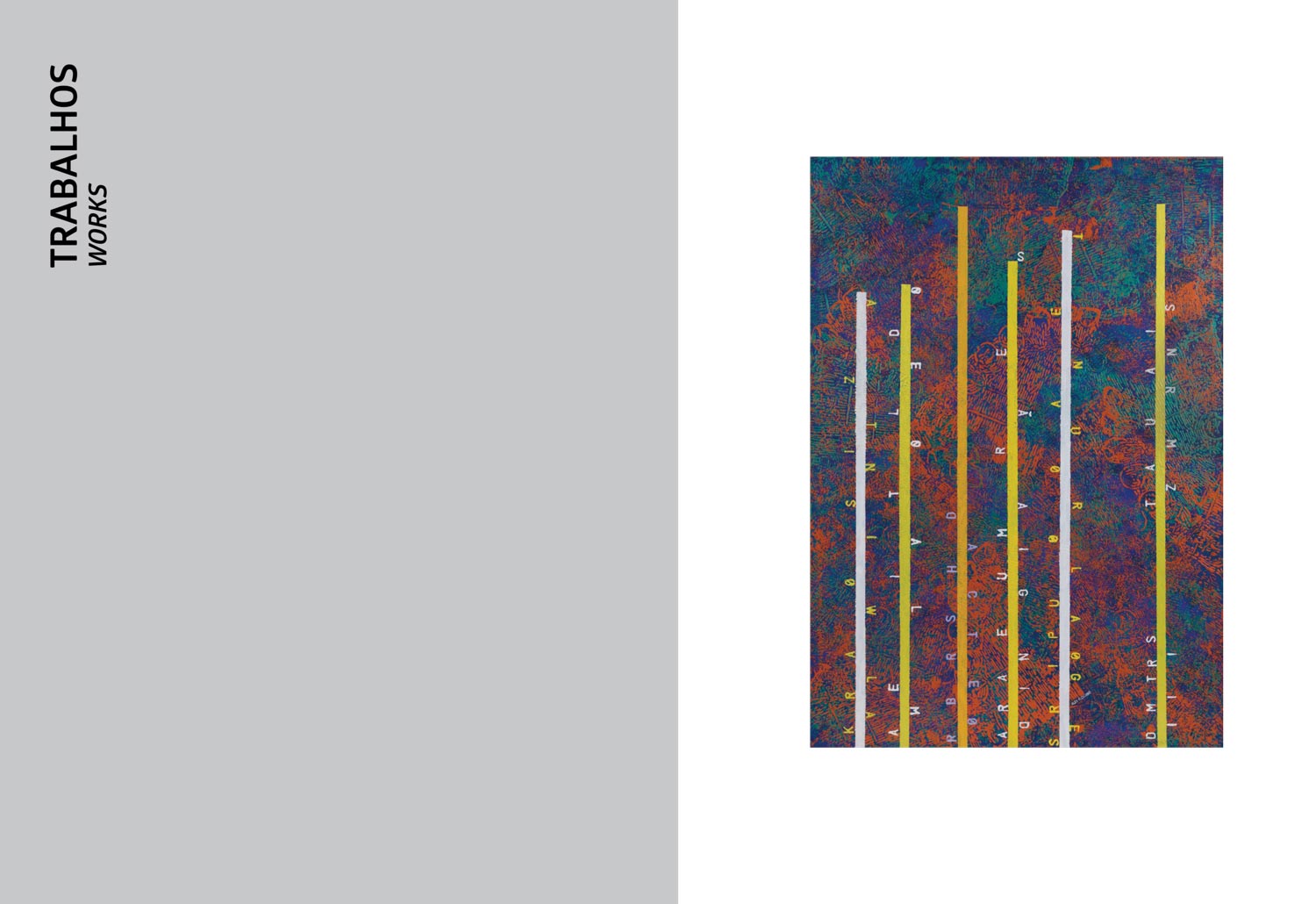
Obra à direita:
Sem Título (Série Alturas) / Untitled (Height Series) acrílica sobre tela / acrylic on canvas 200x140cm
Berlin 1994
Karla Woisnitza, Amelia Toledo, Robert Schad, Adriane Guimarães, Sergio Paulo Rouanet, Dimitris Tzamuranis
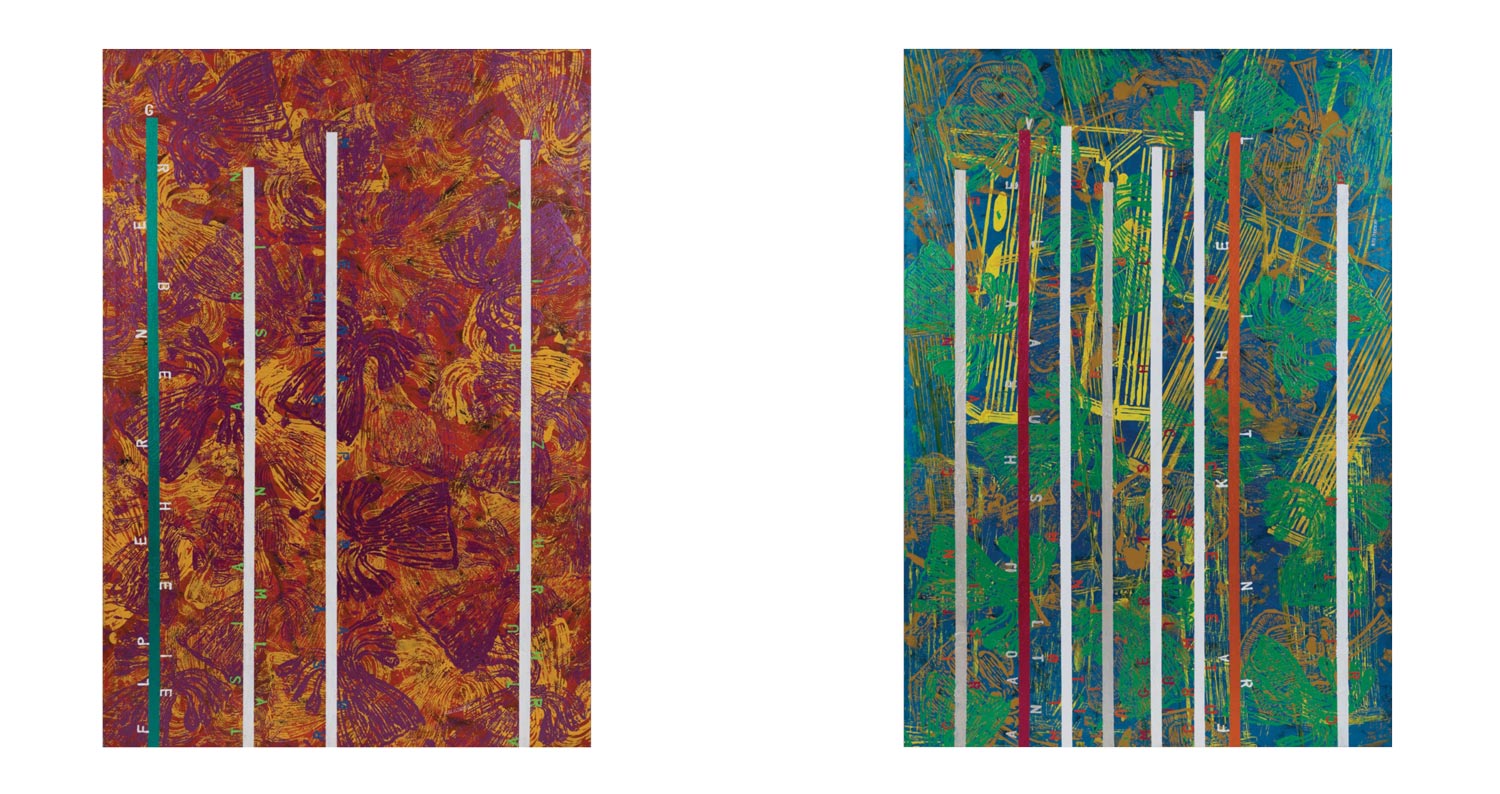
Obra à esquerda:
Sem Título (Série Alturas) / Untitled (Height Series) acrílica sobre tela / acrylic on canvas
200 x 140 cm
Berlin 1995
Felipe Ehrenberg; Taslima Nasrin; Rosa von Praunheim; Arthur Luiz Piza
Obra à direita:
Sem Título (Série Alturas) / Untitled (Height Series) acrílica sobre tela / acrylic on canvas
200 x 140 cm
Berlin 1995
Cristina Canale; Anatolij Shuravlev; Milton Hatoum; Luiz Pizarro; Miguel Rotschild; Kurt Meyer-Clason; Frank Thiel; Cristina Pape
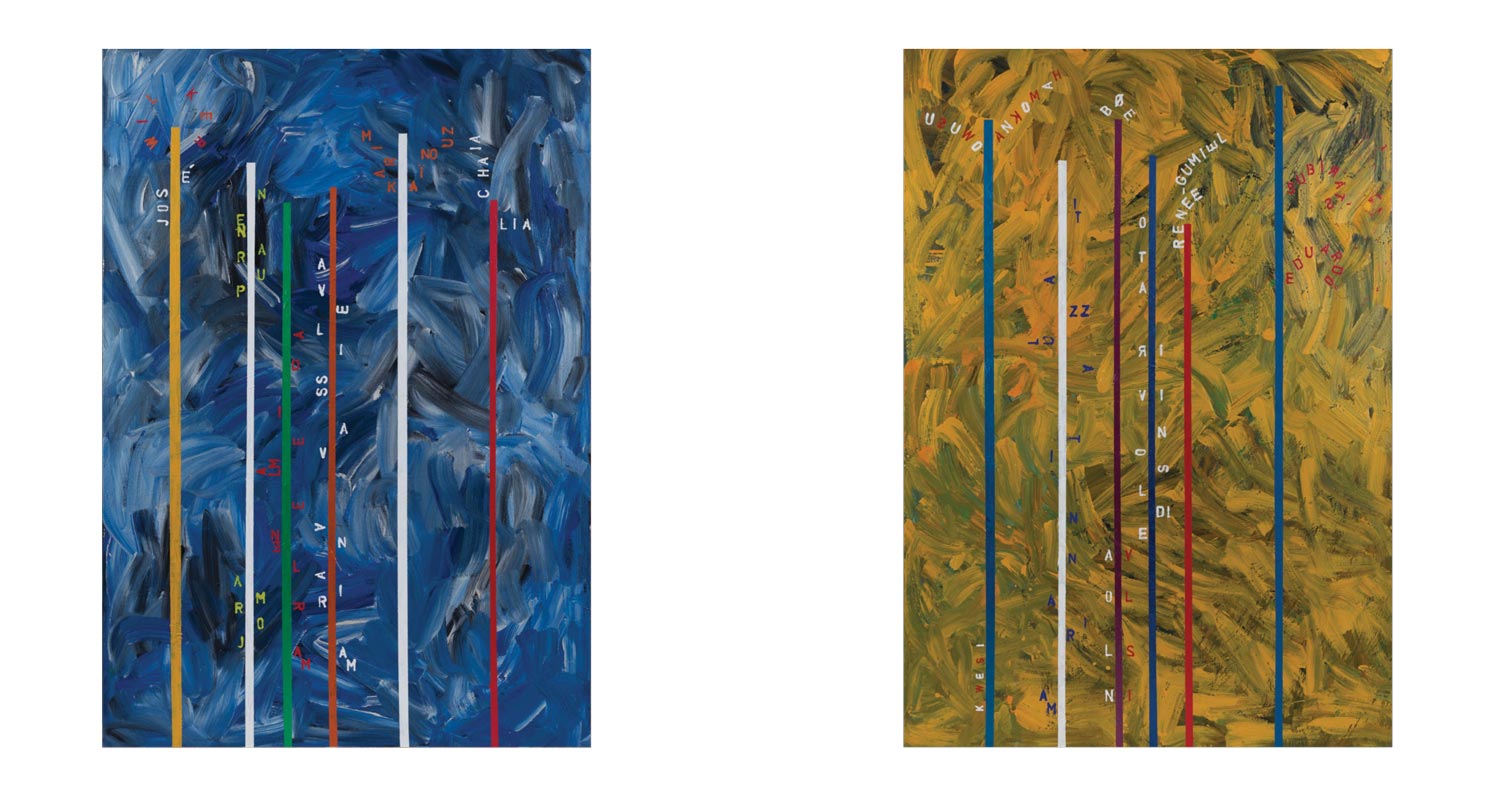
Obra à esquerda:
Sem Título (Série Alturas) / Untitled (Height Series) acrílica sobre tela / acrylic on canvas
200 x 140 cm
Berlin 2004
José Wilker; Jorma Puranen; Marlene Almeida; Mariana Vassileva; Karin Aïnouz; Lia Chaia
Obra à direita:
Sem Título (Série Alturas) / Untitled (Height Series) acrílica sobre tela / acrylic on canvas
200 x 140 cm
Berlin 2005
Kwesi Owuso Ankomah; Mariannita Luzzatti; Nils Olav Boe; Edilson Viriato; Renné Gumiel; Eduardo Subirats
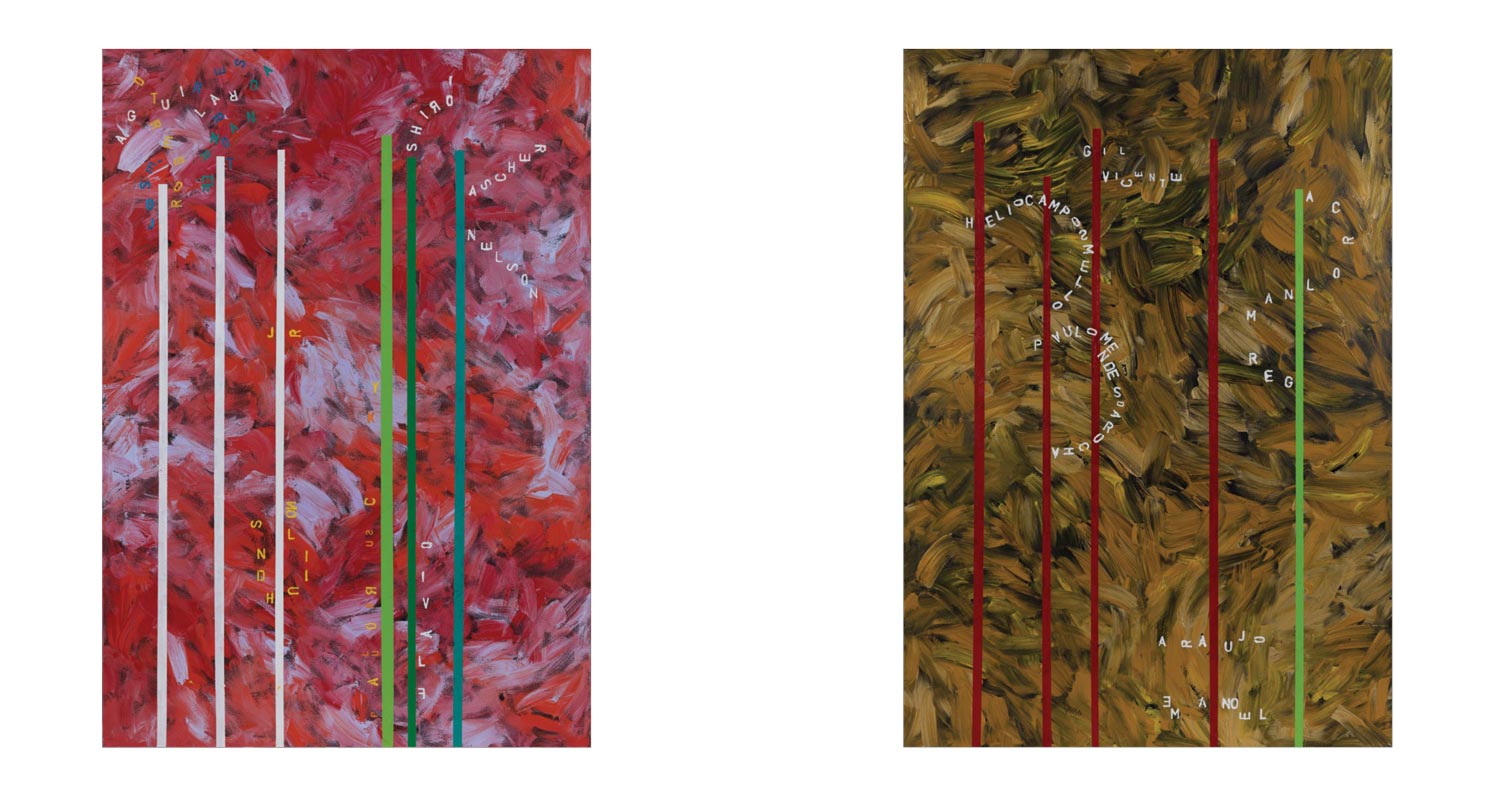
Obra à esquerda:
Sem Título (Série Alturas) / Untitled (Height Series) acrílica sobre tela / acrylic on canvas
200 x 140 cm
São Paulo 2005
José Roberto Aguilar; Fernanda Torres; Hudinilson Jr.; Paulo Bruscky; Flávio Shiró; Nelson Ascher
Obra à direita:
Sem Título (Série Alturas) / Untitled (Height Series) acrílica sobre tela / acrylic on canvas
200 x 140 cm
São Paulo, 2007
Hélio Campos Mello; Paulo Mendes da Rocha; Gil Vicente; Emanuel Araújo; German Lorca
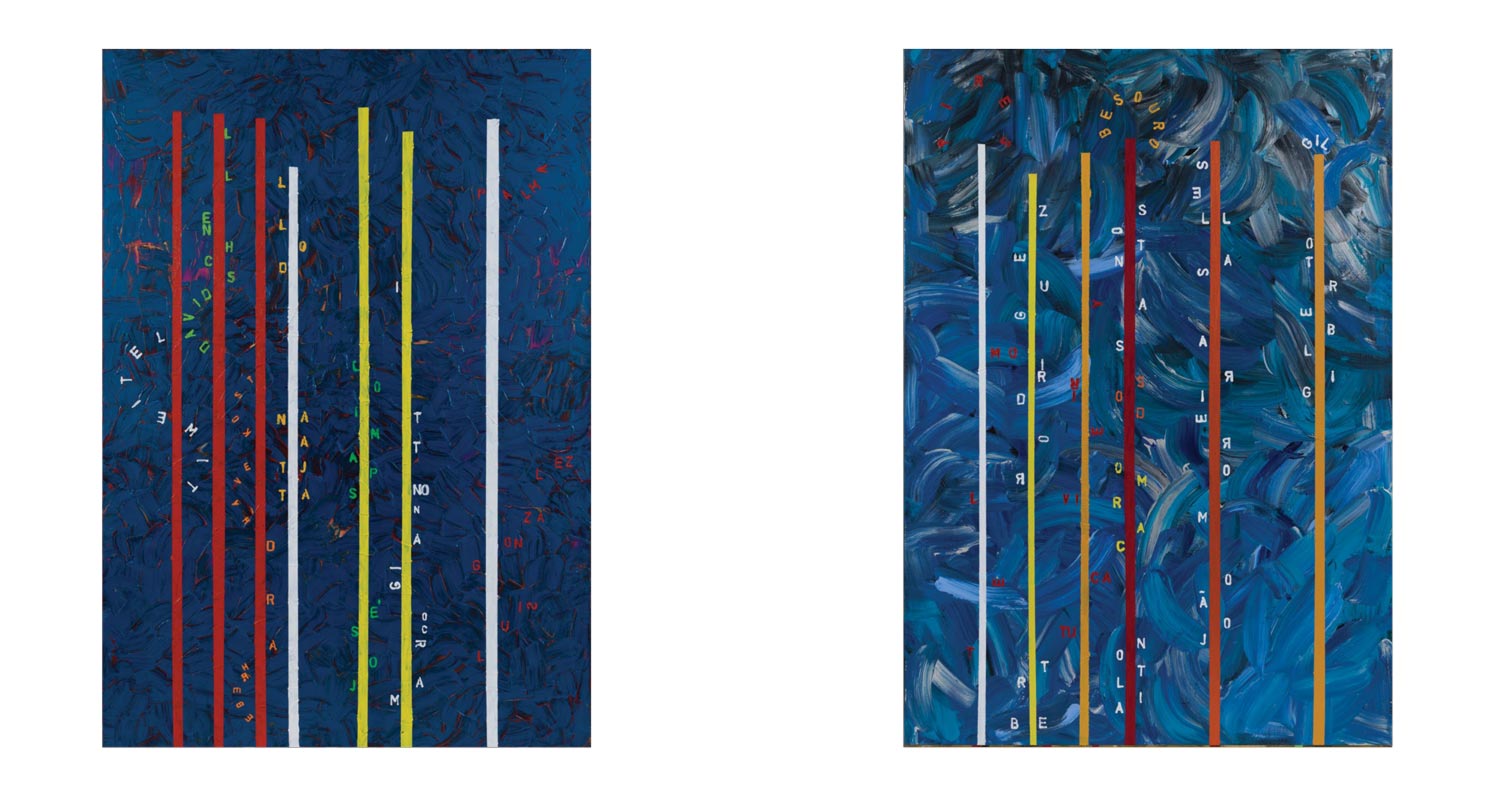
Obra à esquerda:
Sem Título (Série Alturas) / Untitled (Height Series) acrílica sobre tela / acrylic on canvas
200 x 140 cm
São Paulo, 2010
Tim Eitel; David Schnell; Eberhard Havekost; Tatjana Doll; José Spaniol; Marco Gianotti; Luis Gonzalez Palma
Obra à direita:
Sem Título (Série Alturas) / Untitled (Height Series) acrílica sobre tela / acrylic on canvas
200 x 140 cm
Berlin, 2010
Telmo Pires; Bert Rodriguez; Tuca Vieira; Ailton Carmo dos Santos Besouro;
João Moreira Salles; Gilberto Gil
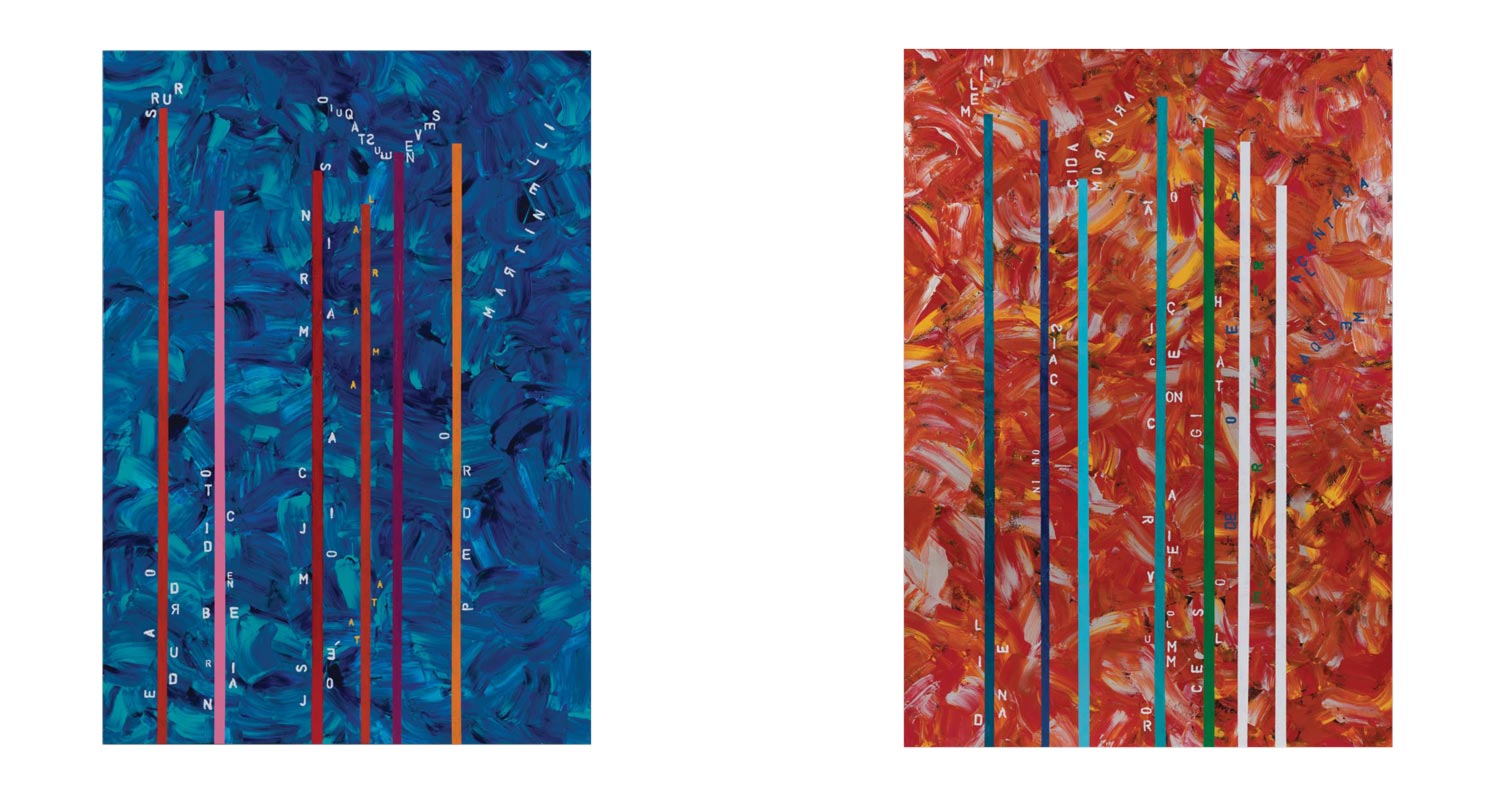
Obra à esquerda:
Sem Título (Série Alturas) / Untitled (Height Series) acrílica sobre tela / acrylic on canvas
200 x 140 cm
São Paulo 2013
Eduardo Srur; Nair Benedicto; José Mojica Marins, Tata Amaral; Eustáquio Neves; Pedro Martinelli
Obra à direita:
Sem Título (Série Alturas) / Untitled (Height Series) acrílica sobre tela / acrylic on canvas
200 x 140 cm
São Paulo 2014
Daniel Melim; Nino Cais; Rommulo Vieira Conceição; Celso Gitahy; Eder Oliveira; Araquém Alcântara
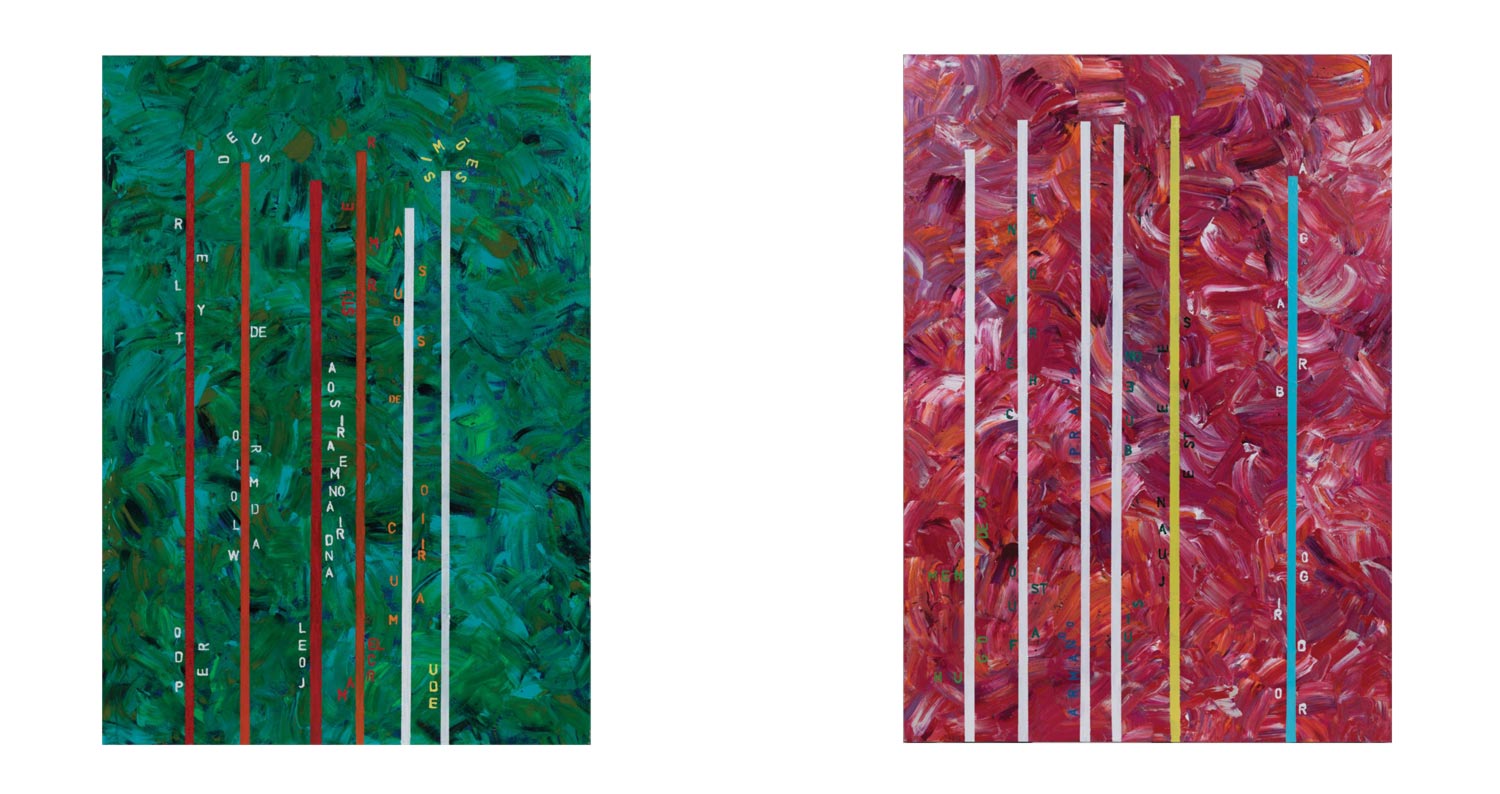
Obra à esquerda:
Sem Título (Série Alturas) / Untitled (Height Series) acrílica sobre tela / acrylic on canvas
200 x 140 cm
São Paulo 2016
Pedro Tyler; Waldomiro de Deus; Joel Andrianomearisoa; Marcel Stürmer; Maurício de Souza; Edu Simões
Obra à direita:
Sem Título (Série Alturas) / Untitled (Height Series) acrílica sobre tela / acrylic on canvas
200 x 140 cm
São Paulo 2018
Hugo Mendes; Fausto Chermont; Armando Prado; Luis Bueno; Juan Esteves; Rodrigo Braga
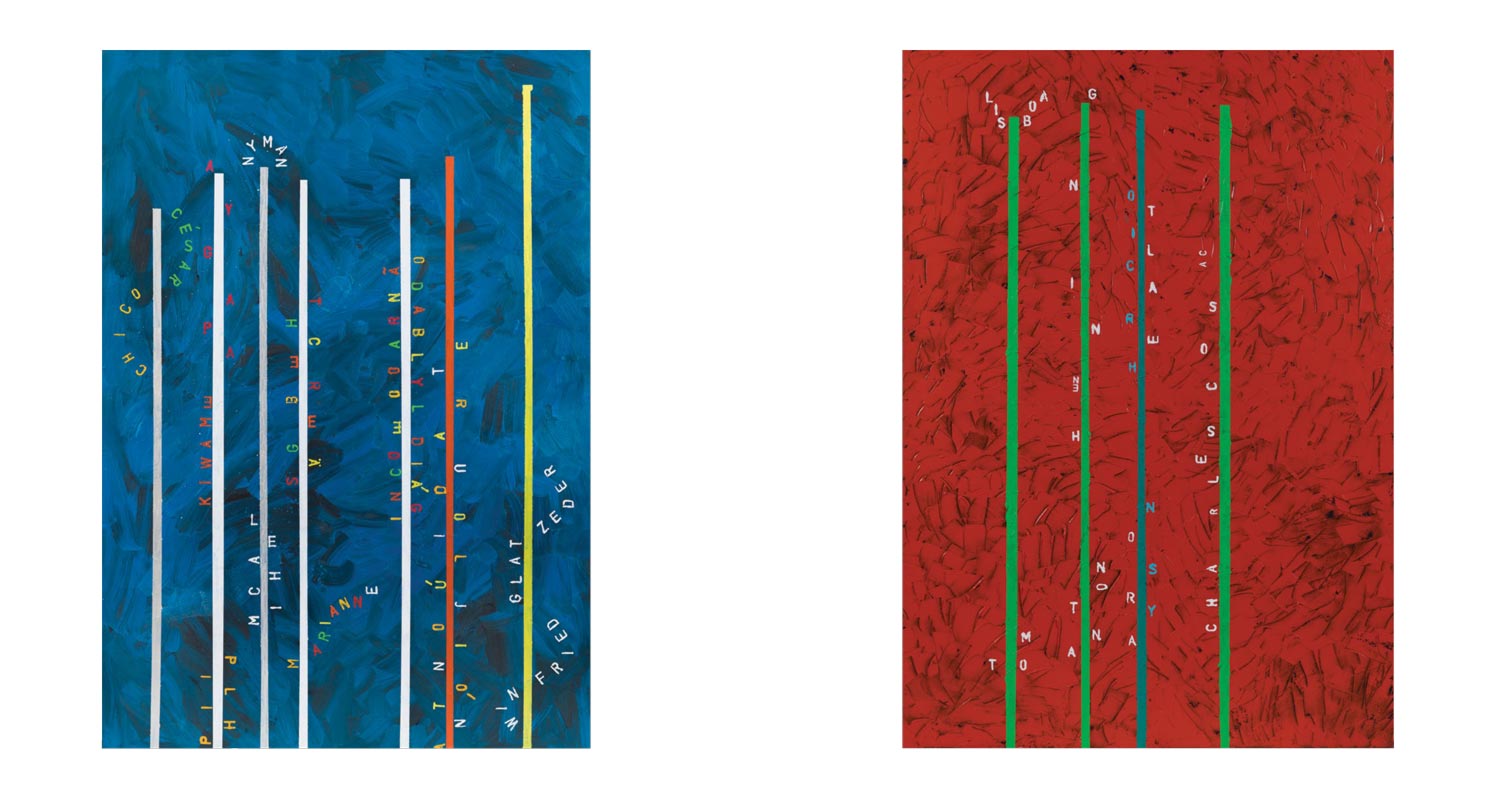
Obra à esquerda:
Sem Título (Série Alturas) / Untitled (Height Series) acrílica sobre tela / acrylic on canvas
200 x 140 cm
Berlin 2000
Chico César; Philip Kiwame Apagya; Michael Nyman; Marianne Sägebrecht; Ignácio de Loyola Brandão; Antonio Júlio Duarte; Winfried Glatzeder
Obra à direita:
Sem Título (Série Alturas) / Untitled (Height Series) acrílica sobre tela / acrylic on canvas
200 x 140 cm
São Paulo 2012
Tom Lisboa; Anton Henning; Ayrson Heráclito; Charles Cosac
